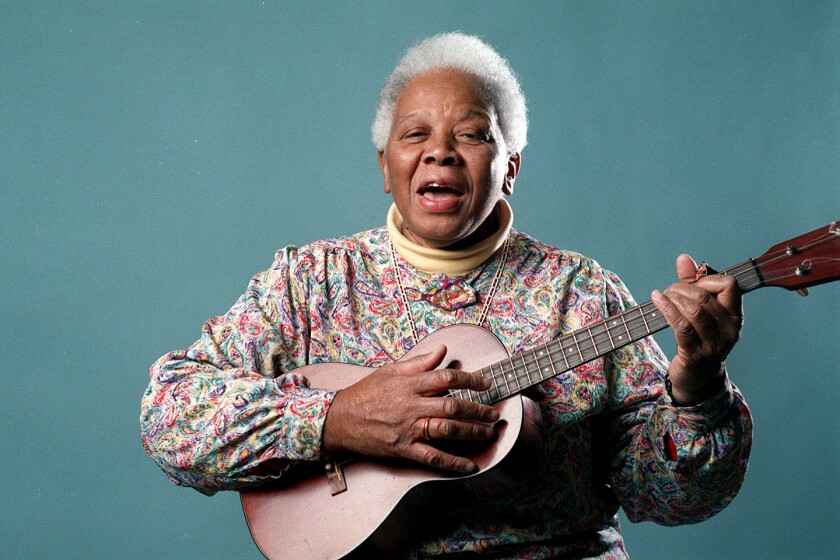
Ella Jenkins was born Ella Louise Jenkins on August 6, 1924, in St. Louis, Missouri, and was a pioneering American singer-songwriter, revered for her contributions to folk and children’s music. Known widely as “The First Lady of the Children’s Folk Song,”.
Ella Jenkins dedicated her 67-year career to creating, performing, and advocating for music that could educate, entertain, and bring together young audiences across cultures. Jenkins’s influential work with children’s music helped establish it as a serious genre, respected not only as an educational tool but as an art form embraced by the music industry.
Early Life and Cultural Influences
Ella Jenkins grew up in Chicago. Her family was part of the Great Migration, a movement of African Americans from the rural South to Northern cities, which exposed her to a blend of cultural influences. Jenkins’s childhood in Chicago, a major hub of African American culture and activism, exposed her to various musical genres, including jazz, gospel, blues, and folk. These early experiences shaped her musical tastes and her belief in the power of music as a means of expression and unity.
In her youth, Jenkins learned to play the harmonica and enjoyed singing. As she grew older, she became increasingly interested in how music could bridge cultural and linguistic divides. Jenkins’s experiences as an African American woman informed her commitment to multiculturalism in music. Her work would later become known for its inclusiveness, blending African American traditions with folk songs, Spanish-language songs, and music from around the world.
Early Career and Breakthrough in Children’s Music
Ella Jenkins studied sociology at San Francisco State University, which fueled her interest in how music can reflect and shape social interactions. After college, she worked as a playground director, where she discovered the power of music in engaging children. This experience planted the seeds for her lifelong dedication to children’s music.
In 1956, Jenkins began her formal career in children’s music when she started performing on a Chicago television program called The Totem Club. Her songs captivated young audiences and laid the foundation for her to transition to live performances at schools, libraries, and community centers. In 1957, she made her first recording with Folkways Records, later known as Smithsonian Folkways. This partnership marked the beginning of a decades-long collaboration that would see her release more than 40 albums, many of which are now staples in the genre of children’s music.
.
.
Innovations in Multicultural Children’s Music
Ella Jenkins was passionate about exposing children to the sounds, languages, and traditions of cultures worldwide. Her landmark album Multicultural Children’s Songs, released in 1995, became one of Smithsonian Folkways’ best-selling records and remains a cornerstone in children’s music. The album features songs in multiple languages, including Swahili, Hebrew, Spanish, and French, introducing children to diverse cultures through music. With songs like “Jambo” (Swahili for “hello”) and “Dulce, Dulce” (a traditional Mexican lullaby), Jenkins demonstrated how music could foster cultural understanding at an early age.
Multicultural Children’s Songs was more than just a collection of tunes; it was a message of inclusivity and respect for cultural diversity. At a time when children’s music often stuck to familiar American nursery rhymes, Jenkins’s approach was groundbreaking. Her insistence on introducing global sounds and languages to children contributed to the mainstreaming of multiculturalism in educational music.
Impact on Children’s Television and Media
Ella Jenkins was also a frequent guest on children’s television shows, notably Mister Rogers’ Neighborhood and Sesame Street. These appearances expanded her influence and reached millions of children who may not have otherwise encountered her music. On Mister Rogers’ Neighborhood, Jenkins shared songs, played the harmonica, and taught children about rhythm and movement, as well as the joy of singing together. Her appearances on Sesame Street introduced her music to a diverse national audience, and her focus on cultural inclusivity aligned well with the show’s mission.
By appearing on popular children’s programs, Jenkins was able to amplify her message of unity and mutual respect, inspiring children to appreciate both their own and others’ cultural backgrounds. She became a familiar and comforting presence in homes across America, reinforcing the idea that children’s music could be a vehicle for learning and empathy.
Grammy Lifetime Achievement Award and Other Honors
In 2004, Ella Jenkins’s contribution to music was recognized with a Grammy Lifetime Achievement Award, a significant milestone not only for her career but also for the genre of children’s music. This award acknowledged her as a leader and pioneer in a field often overlooked by major music institutions. By this time, Jenkins had recorded over three dozen albums, written countless songs, and inspired generations of children and musicians. Her Grammy win underscored her impact on the music industry and validated children’s music as a respected art form.
Beyond the Grammy, Jenkins received numerous honors and accolades. She was inducted into the American Society of Composers, Authors, and Publishers (ASCAP) Foundation’s Wall of Fame and received a Lifetime Achievement Award from the National Association for the Preservation and Perpetuation of Storytelling. These accolades reflect her status not only as a musician but as a cultural educator, advocate, and storyteller..
Educational Philosophy and Approach to Music
Ella Jenkins’s work was rooted in her belief that music is a universal language and that children should be exposed to diverse sounds, rhythms, and languages. She saw her music as a way to teach respect and empathy, stating, “I wanted children to feel that all music is beautiful and that they could understand and appreciate people from different cultures.” This philosophy guided her approach to songwriting and performing.
Jenkins’s style is simple yet effective: she engaged children with call-and-response singing, hand clapping, and rhythmic movements. Her music was interactive, designed to encourage participation and make children active participants rather than passive listeners. This approach has become a staple in children’s music, widely emulated by educators and performers who understand that children learn best when they can engage with the material.
Many of her songs are intentionally repetitive, making them easy for children to learn and remember. For example, “You’ll Sing a Song and I’ll Sing a Song,” one of her most popular tracks, uses a repetitive structure that invites children to join in. This song, like many of her works, is designed to break down barriers and create a shared experience.
.

.
Influence on the Recording Industry
Ella Jenkins’s success paved the way for other artists and helped solidify children’s music as a viable market within the recording industry. Before her, children’s music was often seen as secondary to “serious” music, yet her career helped change this perception. Jenkins proved that children’s music could be educational, fun, and commercially successful.
Mark Guarino, a culture writer, noted that Ella Jenkins’s work “firmly established the genre of children’s music as a serious endeavor — not just for artists to pursue but also for the recording industry to embrace and promote.” Her partnership with Smithsonian Folkways created a model for producing and distributing children’s music that was culturally enriching, and this model is still followed today by artists who seek to create meaningful content for young audiences.
Legacy and Continuing Influence
Ella Jenkins’s influence on children’s music is profound and enduring. Her approach has inspired countless musicians, educators, and parents to see music as a tool for connection and learning. Jenkins’s albums continue to be used in classrooms and homes, introducing new generations to the joys of singing, rhythm, and cross-cultural awareness.
Her work also had a lasting impact on the nonprofit and educational sectors. Smithsonian Folkways, where Jenkins released most of her music, continues to support and promote multiculturalism and folk traditions. Jenkins’s contributions have thus helped shape an institution that remains committed to cultural preservation and education.
In addition to her influence on music, Ella Jenkins is remembered as a trailblazer in advocating for diversity in children’s entertainment. At a time when mainstream children’s media was overwhelmingly homogenous, Jenkins offered an alternative, celebrating a mosaic of cultures and languages. Her legacy can be seen in today’s children’s programming, which often includes diverse representations and multilingual content.
Conclusion
Ella Jenkins’s career spanned more than six decades, during which she changed the landscape of children’s music. Her innovative focus on multiculturalism, simple yet engaging musical style, and dedication to children’s education left an indelible mark on the genre. By the time of her passing on November 9, 2024, Jenkins had achieved what few artists in her field have: she had created a legacy that transcended music itself, leaving behind a model of inclusivity, respect, and joy for future generations to emulate.
Ella Jenkins’s life and work demonstrate the power of music to educate, inspire, and unite people. Her songs continue to resonate with children and adults alike, reminding us of the importance of cultural understanding and the joy of shared musical experiences. Through her dedication and vision, Jenkins will forever be celebrated as the “First Lady of the Children’s Folk Song” and a true pioneer in the world of children’s music.
Check out Ella Jenkins on Amazon.
If you found this interesting please share it with your friends and family, and check out some of our other articles on Musicians who Died in 2024.
.
.

